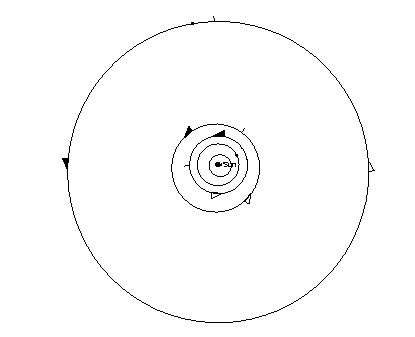
The big gap between the orbits of Mars and Jupiter has no planet, although it contains many minor planets or asteroids. We'll talk about these later.
The Giant Planets
The four planets Jupiter, Saturn,
Uranus, and Neptune are called the giant planets, or
sometimes the jovian planets. They are very
different from the terrestrial planets and their orbits are much
more distant from the Sun. Here is a diagram showing the
orbit of Jupiter (outermost orbit) compared with the orbits of
(going inward) Mars, Earth, Venus, and Mercury:

The big gap between the orbits of
Mars and Jupiter has no planet, although it contains many minor
planets or asteroids. We'll talk about
these later.
Zooming outward, here is a view of
the orbits of (going inward) Neptune, Uranus, Saturn, and
Jupiter:
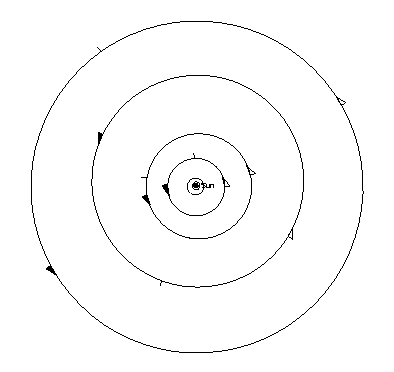
Notice the steadily increasing scale
of these orbits.
The giant planets are in turn divided into two classes:
We will tour some web pages for the giant planets and briefly look at some of their vital statistics.
Things to notice:

For reasons we'll explain later,
these four planets are believed to consist of the following
chemical components from the primordial solar nebula.
First, here is a pie diagram of
solar composition, the same composition as the Sun today.
It is different from the pie diagram shown in the
January 28 lecture because
it is by mass rather than number:

This mixture is about 71% hydrogen and 27% helium by mass. The other 2% is everything else. The biggest giant planets, Jupiter and Saturn, have roughly this same composition.
Our most direct look at the composition of Jupiter: the Galileo entry probe
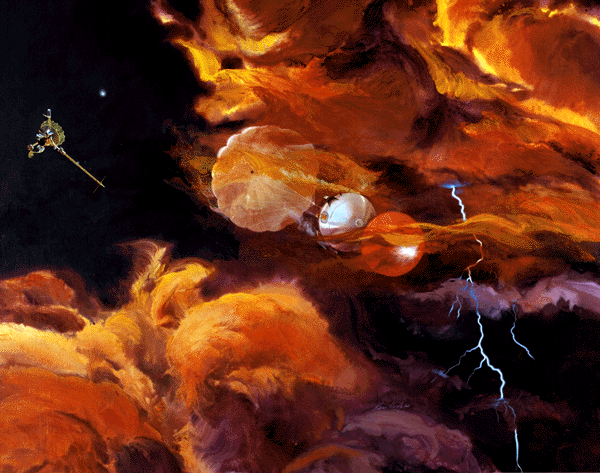
We know that Jupiter's atmosphere
gets very hot as we go in. Jupiter has a very deep
troposphere. In fact, it goes almost all the way to the
center of the planet!
The outer two giant planets, Uranus and Neptune, seem to have lost much of their hydrogen and helium. Instead, they are made up of slightly less volatile elements:
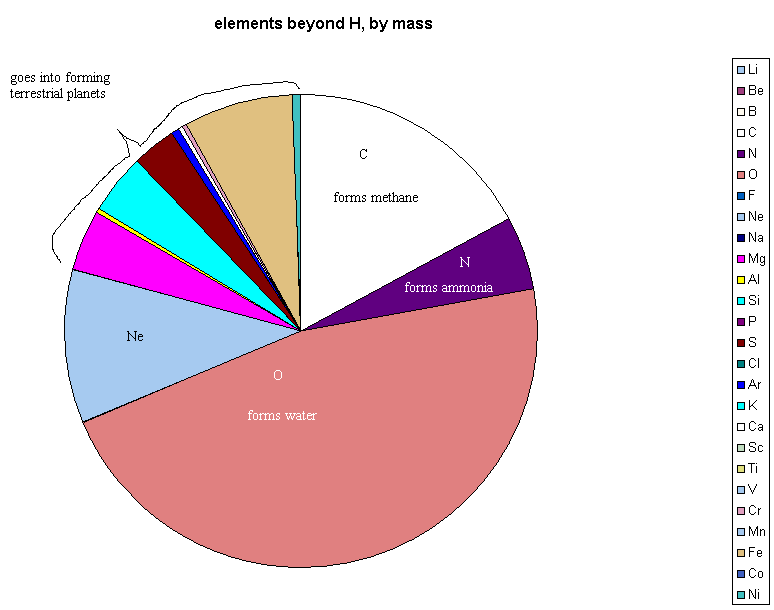
If there is plenty of hydrogen around
(which there is in the outer solar system), the abundant atoms
carbon (C), nitrogen (N), and oxygen (O) tend to form their most
stable hydrides (hydrogen-bonded molecules), which are:
CH4 (methane)
NH3 (ammonia)
H2O (water)
All of these molecules can form
solid phases (ice) where it is very cold in the outer solar
system.
Why do we get hydrogen, helium, methane, ammonia, and water in these planets?
Volatility decreases with temperature, and it's cold in the outer solar system. Easier to include these materials -- especially water.
"Frost line":

At T < 150 K, water acts like rock -- solid, with vapor pressure well below a nanobar.
So solid objects beyond the frost line will include lots of H2O! In fact, more water ice than rock.
Jupiter and Saturn are mostly hydrogen
How do we know?
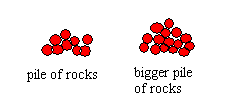
As the mass increases, the size of the pile increases.
But now consider something squashy, like cotton balls:
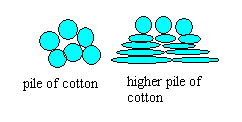
The bottom squashes under the
pressure, and the pile doesn't get much higher. Hydrogen
and helium are very "squashy" substances, and they behave this
way. Jupiter and Saturn are nearly the same size, although
Jupiter is more than 3 times more massive.
Here is a pie diagram that summarizes the differences between the Jupiter-Saturn type of giant planet and the Uranus-Neptune type:
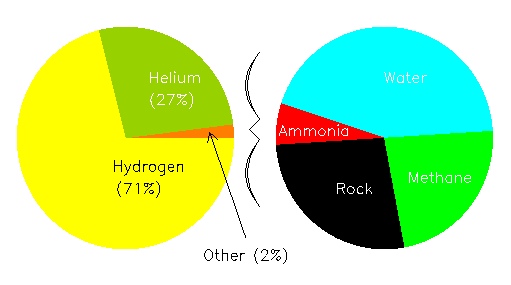
Jupiter and Saturn have compositions
mostly like the diagram on the left, while Uranus and Neptune
have compositions mostly like the diagram on the right, with a
small amount of hydrogen-rich gas on top.
Interiors of giant planets
Here is a cutaway diagram of the structure of some giant planets (both in our solar system and elsewhere):

The object
on the left, Gl229 B, is actually a brown dwarf, while 51 Peg B
is a giant planet with a mass intermediate between Jupiter and
Saturn. It is bigger in size because its interior is much
hotter.
How do we measure the size of the rock-ice cores of giant planets? We use a version of the oblateness method that is used to measure the core size for Earth and Mars:

If the planet doesn't rotate, it takes a spherical shape regardless of its interior structure (a).
But if the planet rotates rapidly,
as all the giant planets do, its shape becomes non-spherical,
and it becomes a combination of (b), (c), and (d). Note
that (c) and (d) are shown greatly exaggerated. The size
of these distortions depends on the core size and other details
of the interior structure.
Saturn's oblateness, caused by its rapid rotation and large J2 , is easily visible in images. The planet is flattened at its poles:
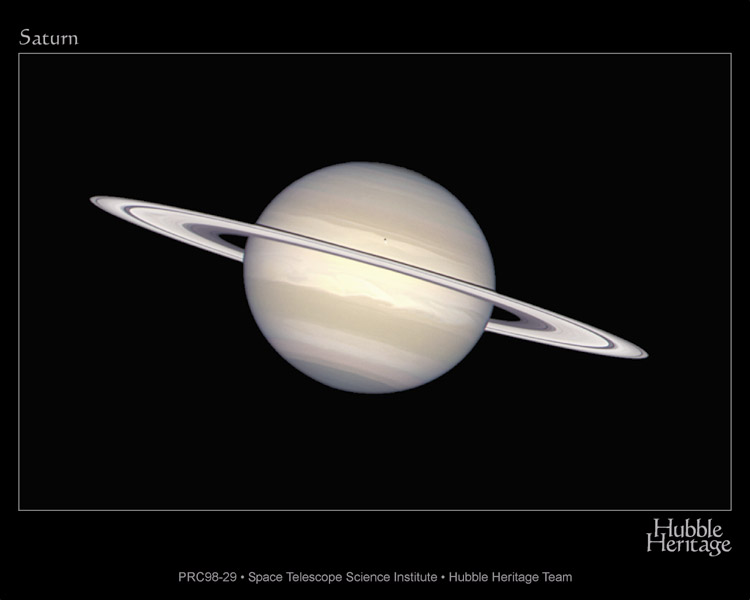
Three of the giant planets emit about as much infrared energy into space as they receive from the Sun. This is very different from the Earth and the other terrestrial planets.
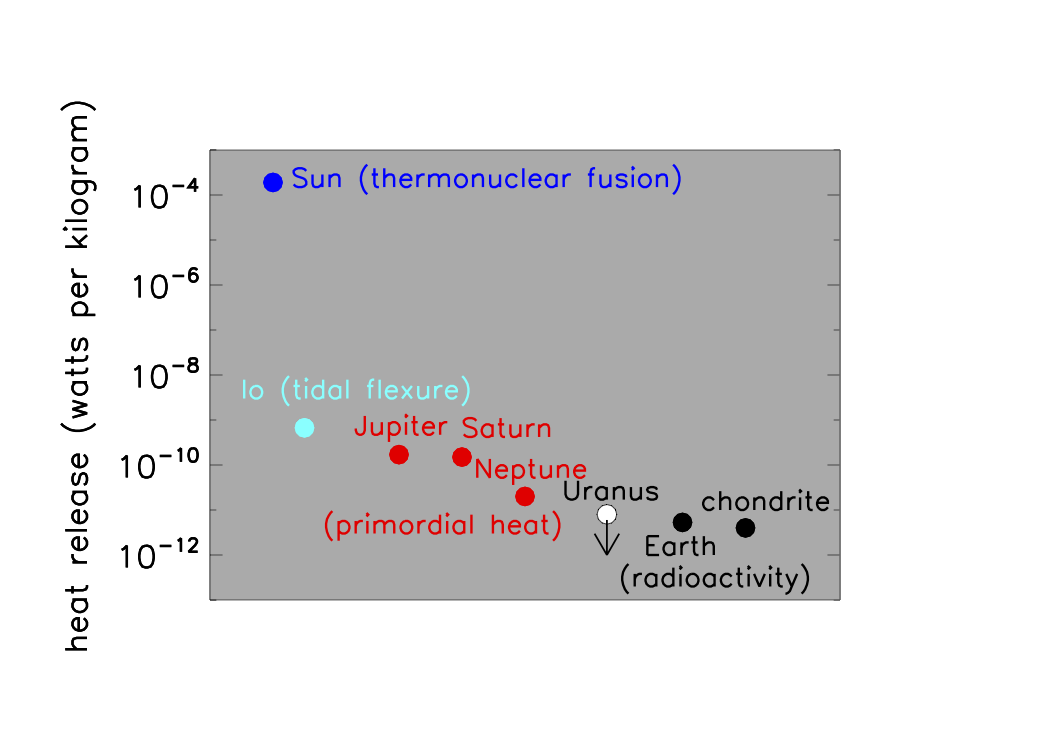
In this figure, chondrite refers to a primitive type of meteorite. Both chondrites and the entire Earth release radioactive heat at about the same rate. This energy comes mainly from the decay of isotopes of potassium, uranium, and thorium, as we have already discussed.
There is only an upper limit on the heat release from Uranus. This planet appears to be a very inactive body. Its atmosphere is also very inactive. The cause of Uranus' inactivity is unknown.
Where does the energy of Jupiter and Saturn come from?
It comes from gravitational
contraction and cooling, left over from the time when the giant
planets formed 4.5 Gyrs ago. The
figure below shows how giant planets shrink as they cool
off. Beginning at about 13 or 14 Jupiter masses, there is
a brief pause in the shrinkage because the center of a giant
planet that has at least this mass will reach a temperature in
excess of about half a million K, permitting deuterium to fuse
into helium and releasing energy. Objects above this mass
are called brown dwarfs
rather than giant planets:
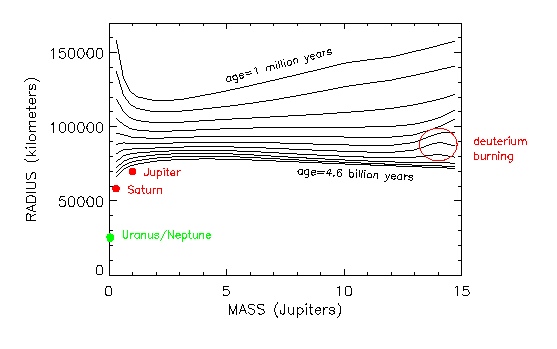
Brown
dwarfs are misnamed. Unlike Jupiter, they don't shine by
reflected starlight.
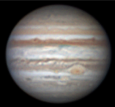
Rather, they glow faintly at visible wavelengths by radiating
primordial heat from their interior, and the less massive
"brown" dwarfs actually have a dark magenta color, like this:

Scientists
continue
to argue about the difference
between a giant planet like Jupiter and a brown dwarf.
Giant
Planet
Magnetospheres
Jupiter has a strong magnetic field, with Van Allen belts, aurorae, and a magnetosphere.
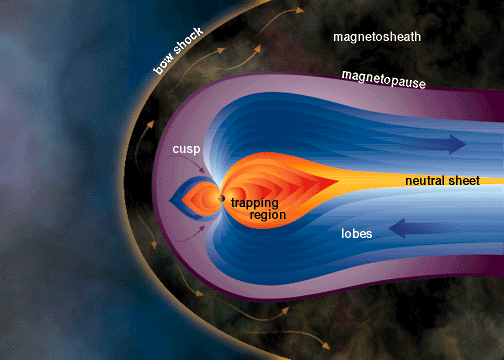
Click here for a movie of the Jupiter magnetosphere.
Jupiter's strong magnetic field is produced by convection currents in the liquid metallic-hydrogen interior. These currents have to move at speeds of about 1 cm/second to get the heat out of Jupiter. The result is a field of about 4 gauss at Jupiter's equator. This is about 10 times larger than Earth's field.
The magnetic fields of most planets (the planets that have one) resemble the field of a simple bar magnet. The field is produced by electrical currents deep within the planet. Usually, the axis of the equivalent bar magnet is tilted to the rotation axis, which causes the external field to vary with time as the planet rotates.
movie of rotation of a tilted bar magnet
Here is a movie showing rotation of Jupiter's magnetic field. The orbital path of the Juno orbiter spacecraft (launched in August 2011; arrival at Jupiter in mid-2016) is also shown. This spacecraft will make close-range measurements of Jupiter's gravitational and magnetic fields during more than 30 orbital passes.
movie of rotation of Jupiter and its magnetic field